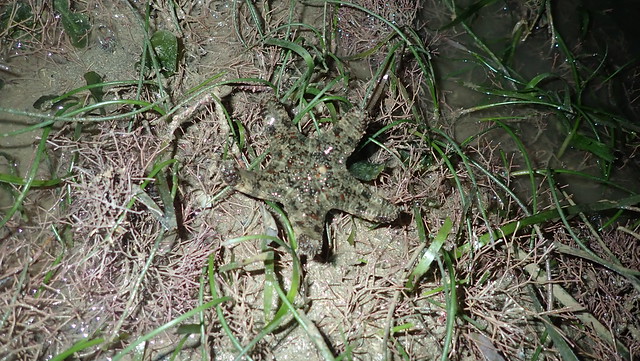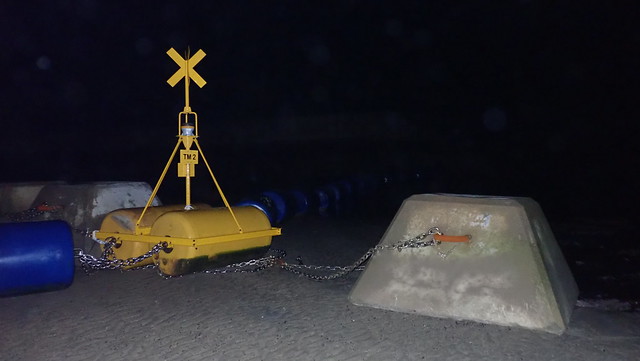There are some impressive corals on this shore near the seawalls. On the horizon, the lights of the many large ships parked off the East Coast.
Can we plan coastal works to allow reefs, mangroves and seagrasses to naturally regenerate? Naturalise canals leading to the sea for a continuum of freshwater wetlands to mangroves? Imagine what's possible! Reefs and natural marine ecosystems at our doorstep, for all in the City to enjoy.
I last surveyed the reefy portion of the shore in Apr 2016. The situation seems similar, although I sense the colonies have grown much bigger. All corals were healthy and well formed. I saw many Boulder pore corals and Branching pore corals. There were many Disk corals of various kinds. Merulinid (previously Favid) corals are still abundant with many different kinds seen. There were also some Anemone corals.
So nice to see corals and seagrasses growing next to one another.
Sue spotted this small Cake sea star. There were also many Cake sand dollars on the sandy areas. Eugene had a close encounter with a Stonefish! Fortunately, no one was harmed.
It was great to see many sea cucumbers. Some parts of the seagrass meadows were dotted with Tiny red sea cucumbers. In the sand bar, we came across several large Remarkable sea cucumbers, our first time for this location. I also saw one Beige sea cucumber and one Ball sea cucumber.
We also saw some special snails today. Victor found a Ramose murex, Kelvin found a Fig snail. There were lots of many Arabian cowries. Also some Ovum cowries. In the sand bar, there were many Olive snails, some Oval moon snails. I also saw one Speckled whelk which I rarely encounter.
There were some large Fan clams in the seagrassy areas. I didn't come across any large patches of other clams in the seagrass areas.
I saw one Giant carpet anemone, a small Striped sand anemone and one unidentified sea anemone.
It was nice to see long Tape seagrass. Including this clump growing inside the canal! But I didn't see any that were flowering. Our last survey here in May 2018.
The most abundant were Spoon seagrass, both large and small leaved; Needle seagrass, both broad and narrow leaved. There were dense patches of Noodle seagrass, many clumps of Tape seagrass. some Sickle seagrass and Smooth ribbon seagrass. I didn't see Serrated ribbon seagrass which I saw in May 2018.
The walls of the canal are coated with marine life! With a wider variety towards the sea. These include snails, limpets, slugs and crabs! Indeed, this shore is quite rich. We surveyed it earlier in Aug 2019 for the Singapore Marine Fishes Expedition 2019, and it did yield some of our richest fish finds for the Expedition.
It seems there has been work recently in the area to replace the blue drums and other large structureds across the mouth of the canal, which acts as a security barrier. Apparently, dredging was also done (observed by a survey team member earlier on). It's a relief to see that most of the seagrasses and corals are not badly affected by these works.
In the Draft Master Plan 2019 that affects our Eastern shores, plans for 'Changi City' may impact corals reefs and seagrass meadows that have settled on the artificial shores at Tanah Merah and East Coast Park. This shore is probably already impacted by massive new reclamation, currently ongoing. But such plans may also be an opportunity to incorporate and nurture the amazing marine life that is already found there.
Natural regeneration on Singapore's artificial shores and structures is already happening now. Unintentionally, with zero replanting. Recently announced plans for more reclamation in response to rising seas is a great opportunity to build shore structures that allow marine life to settle and grow. Can we plan coastal works to allow reefs, mangroves and seagrasses to naturally regenerate? Naturalise canals leading to the sea for a continuum of freshwater wetlands to mangroves? Imagine what's possible! Reefs and natural marine ecosystems at our doorstep, for all in the City to enjoy. More about this idea in my feedback to the Draft Master Plan 2013.
 |
| click on image for larger view. |
Photos by others on this trip
Kelvin Yong
Eugene Tan and more by Eugene Tan
Lee Sim Eng and Victor Toh
Sue Ye via Marine Stewards
Others on this trip: Dave Koh.
Meanwhile, Jianlin Liu surveyed a Changi shore on the same tide.














